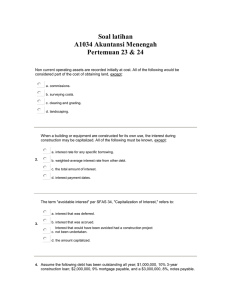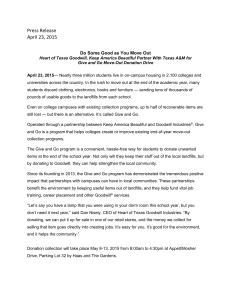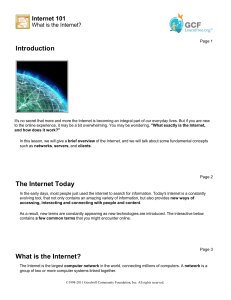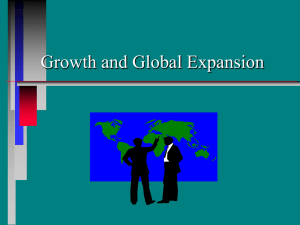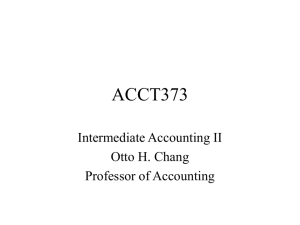change in the cpa profession and the challenge of the future
advertisement
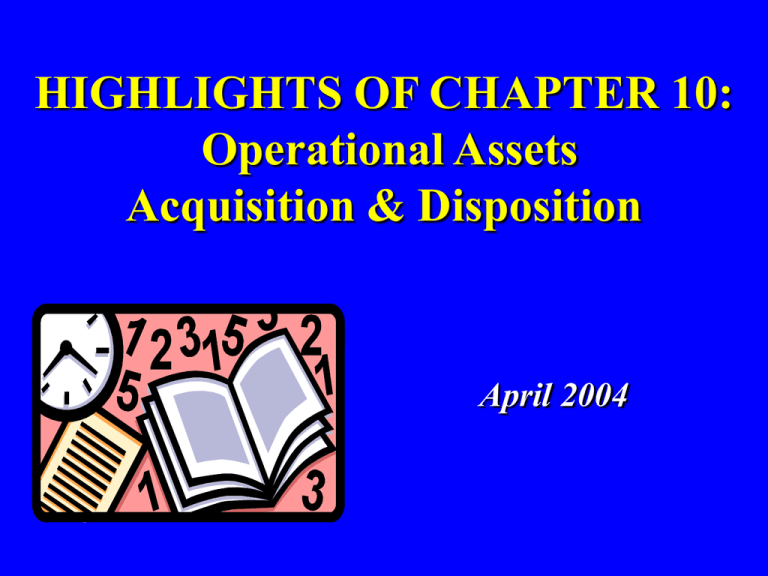
HIGHLIGHTS OF CHAPTER 10: Operational Assets Acquisition & Disposition April 2004 SIGNIFICANT ISSUES Types of OA Costs included in OA Allocation of lump-sum purchase Cost under deferred payment contract Exchange for stock & donations Dispositions & exchanges Self-constructed assets Interest capitalization Costs of purchased & internal intangibles CHARACTERISTICS OF PPE For use & not resale Long-term Subject to depreciation Physical existence CHARACTERISTICS OF INTANGIBLE ASSETS Lack physical substance Not financial instruments Long-term Subject to amortization . . . or not? COSTS INLUDED Historical cost Desired location and condition for use COSTS INLUDED Equipment Land Buildings Natural resources NATURAL RESOURCES Acquisition costs Exploration costs Development costs Asset retirement obligation IDENTIFIABLE INTANGIBLE ASSETS Patents Copyrights Trademarks, tradenames Franchises, license Goodwill Customer related (customer lists, backlogs) CONCEPT OF GOODWILL Value of existing business in excess of value of individual assets Products Brand names Employees & management Customer base Structure RECORDING GOODWILL Can’t record internally generated goodwill Capitalize only purchased goodwill RECORDING GOODWILL Revalue acquired assets & liabilities Goodwill is “excess of cost over fair value of net assets acquired” NEGATIVE GOODWILL Unusual situation “excess of fair value of net assets acquired over cost” Record in income as an extraordinary gain GOODWILL Amortize or record impairment in value . . .? OTHER VALUATION ISSUES Lump sum purchase Issuance of stock Donations of assets Deferred payment contracts (Notes payable) Net cash discounts Exchanges of nonmonetary assets FIXED-ASSET TURNOVER RATIO Net Sales Fixed-asset turnover ratio = -----------------------Average fixed assets DISPOSING OF OA Gain/loss on disposal OA held for sale Impairment loss Not depreciated or amortized Involuntary conversions (Extraordinary gain/loss?) EXCHANGES OF NONMONETARY ASSETS Dissimilar - Recognize gains/losses Similar - Defer gains/Recognize losses Similar assets with cash(“boot”) Partial recognition of gains/Recognize losses SELF-CONSTRUCTED ASSETS Direct costs Fixed overhead How far should you go? INTEREST CAPITALIZATION Qualifying assets Construction period Amount to capitalize Lower of actual or avoidable Weighted average expenditures Interest rate - specific or average? INTEREST CAP EXAMPLE WEIGHTED-AVERAGE EXPENDITURES Date 1-1 3-1 5-1 12-31 Amount Paid $210,000 300,000 540,000 450,000 $1,500,000 Period 12/12 10/12 8/12 0 Weighted Average Cost__ $210,000 250,000 360,000 0__ 820,000 INTEREST CAP EXAMPLE WEIGHTED-AVERAGE INTEREST RATE Principal 15% construction loan $750,000 Interest $112,500 10% 5-year note 12% 10-year bond 55,000 72,000 $127,000 550,000 600,000 $1,150,000 Weighted-average rate = 127,000/1,150,000= 11.04% INTEREST CAP EXAMPLE AVOIDABLE INTEREST COMPUTATION Weighted Average Cost $750,000 _70,000 $820,000 Interest Rate 15% 11.04% Avoidable Interest $112,500 7,728 $120,228 INTEREST CAP EXAMPLE MAXIMUM INTEREST CAP ALLOWED Principal Interest 15% construction loan $750,000 $112,500 10% 5-year note 550,000 55,000 12% 10-year bond 600,000 72,000 $239,500 Avoidable interest $120,228 < $239,500 OTHER INTEREST CAPITALIZATION POINTS Disclosure of interest capitalized Net interest income RESEARCH & DEVELOPMENT COSTS Generally expense as incurred Alternative future use, then capitalize (amortize or depreciate) R&D performed for others Purchased R & D COSTS SIMILAR TO R&D Start-up costs Initial operating losses Computer software costs COMPUTER SOFTWARE COSTS External use Expense until technologically feasible Alternative use - capitalize Amortize based on greater of % of revenue or straight-line Value at lower of amortized cost or net realizable value COMPUTER SOFTWARE COSTS Internal use SOP 98-1 Expense preliminary project costs Capitalize application development costs Expense training & application maintenance costs OIL & GAS ACCOUNTING Successful efforts Full-cost
